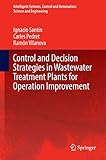Control and Decision Strategies in Wastewater Treatment Plants for Operation Improvement [electronic resource] / by Ignacio Santín, Carles Pedret, Ramón Vilanova.
By: Santín, Ignacio [author.] .
.
Contributor(s): Pedret, Carles [author.] | Vilanova, Ramón [author.]
| Vilanova, Ramón [author.] | SpringerLink (Online service)
| SpringerLink (Online service) .
.
Material type:  BookSeries: Intelligent Systems, Control and Automation: Science and Engineering: 86Publisher: Cham : Springer International Publishing : Imprint: Springer, 2017Edition: 1st ed. 2017.Description: XII, 124 p. 70 illus., 57 illus. in color. online resource.Content type: text Media type: computer Carrier type: online resourceISBN: 9783319463674.Subject(s): Control engineering
BookSeries: Intelligent Systems, Control and Automation: Science and Engineering: 86Publisher: Cham : Springer International Publishing : Imprint: Springer, 2017Edition: 1st ed. 2017.Description: XII, 124 p. 70 illus., 57 illus. in color. online resource.Content type: text Media type: computer Carrier type: online resourceISBN: 9783319463674.Subject(s): Control engineering1 Introduction -- 2 Process modelling and simulation scenarios -- 3 Control approaches -- 4 Tracking improvement of the basic lower level loops -- 5 Variable dissolved oxygen set-points operation -- 6 Denitrification and nitrification processes improvement for avoiding -- 7 Effluent predictions for violations risk detection -- 8 Advanced decision control system -- 9 Conclusions.
This book examines the operation of biological wastewater treatment plants (WWTPs), with a focus on maintaining effluent water quality while keeping operational costs within constrained limits. It includes control operation and decision schemes and is based on the use of benchmarking scenarios that yield easily reproducible results that readers can implement for their own solutions. The final criterion is the effect of the applied control strategy on plant performance – specifically, improving effluent quality, reducing costs and avoiding violations of established effluent limits. The evaluation of the different control strategies is achieved with the help of two Benchmark Simulation Models (BSM1, BSM2). Given the complexity of the biological and biochemical processes involved and the major fluctuations in the influent flow rate, controlling WWTPs poses a serious challenge. Further, the importance of control goal formulation and control structure design in relation to WWTP process control is widely recognized. Of particular interest are the regulations governing the compliance with effluent criteria. Authorities measure compliance with these criteria on the basis of long or short timeframes, and the legal constraints imposed on effluent pollutant concentrations are among the most essential aspects of control structures for WWTPs. This book explores all these facets in detail.


There are no comments for this item.